The world’s largest, most visited museum, the Louvre Museum (Musée du Louvre), will reopen on Monday on a reduced scale due to pandemic-induced precautions and the absence of its usual US and Asian visitors.
The coronavirus has already caused more than €40 million in losses, said the museum’s CEO, Jean-Luc Martinez, who is bracing for three financially tough years. He advocates recovery focusing on “cultural democratisation,” targetting young people and more modest segments of the public, such as Île-de-France residents.
Under the new dispensation, 70% of the public institution – 45,000 m2 – will be accessible. The most visited areas, along with the Ancient World, particularly Ancient Egypt, will be open to the public. However, the areas that are the most complex to manage will remain closed for the moment.
"We are losing 80% of our public,” Martinez said at a press conference last week. “75% of our visitors are foreign. We’re going to have, at best, 20% to 30% of our Summer 2019 public, at most 4,000 to 10,000 visitors daily.” There will be no question of turning visitors away, as occurred on some summer days last year, he added.
Time-stamped reservations, possible since 15 June on the Internet, are the number one way to be able to visit the Louvre, but it is also possible to take a chance and go directly to the museum to see if there are any vacant slots.
Visitors will have to wear face masks. There will be no cloakrooms or refreshment bars, all circuits will be marked with arrows without any possibility of turning back, and exits will all be final.
In front of the Mona Lisa portrait, where tourists from all over the world flock to take selfies, separation markers have been glued to the floor to prevent crowding. To increase the number of visitors, there will be free “mini-discovery” visits not requiring reservations as well as guided tours for youths.
The more than three months that the museum had been closed enabled communication teams to develop the virtual museum online, with many films, podcasts and games. It has received a great many visits, leading to hopes that this online frequentation will encourage the public, particularly young people, to move around in the rooms and enjoy the relative calm that facilitates contemplation.
The museum is working with the Ministry of Culture on a transformation plan, the CEO said, without going into details. “We need to be on hand in 2023-2024 and prepare for the Olympics. Having longer opening hours and more rooms is the challenge for 2024,” he said.
The Brussels Times

